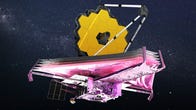Awe-Inspiring Webb Telescope Image Shows Thousands of Glowing Galaxies
The universe is a place of awe. A new James Webb Space Telescope image reveals thousands of galaxies seen in just one little slice of the sky. Take your time. Notice the spirals. The distant glowing specks. The sparkling stars. The sheer number of galaxies.
“This beautiful color image unveils in unprecedented detail and to exquisite depth a universe full of galaxies to the furthest reaches, many of which were previously unseen by Hubble or the largest ground-based telescopes, as well as an assortment of stars within our own Milky Way galaxy,” NASA said in a statement on Wednesday. The stars are the objects with spikes of light coming out of them.
JWST is a joint project of NASA, the European Space Agency and the Canadian Space Agency. Here’s the full spread of the image they shared.
Webb’s view of a particular swath of sky captured thousands of galaxies in one image. Interesting galaxies are highlighted in the pop-outs.
NASA/ESA/CSA/Rolf A. Jansen (ASU)/Jake Summers (ASU)/Rosalia O’Brien (ASU)/Rogier Windhorst (ASU)/Aaron Robotham (UWA)/Anton M. Koekemoer (STScI)/Christopher Willmer (University of Arizona)/JWST PEARLS Team/Rolf A. Jansen (ASU)/Alyssa Pagan (STScI)
This section of the sky is called the North Ecliptic Pole. Webb used its Near-Infrared Camera (NIRCam) and researchers spruced up the view by adding ultraviolet and visible-light data from the Hubble Space Telescope. The image is part of a paper published in the Astronomical Journal this week.
The knockout space view comes to us courtesy of the Prime Extragalactic Areas for Reionization and Lensing Science (Pearls) project. The program’s goal is to study how galaxies assemble and grow. The Pearls team is thrilled about the image. “I can see streams, tails, shells, and halos of stars in their outskirts, the leftovers of their building blocks,” said research scientist Rolf Jansen of Arizona State University.
Hubble and James Webb Space Telescope Images Compared: See the Difference
See all photos
You may have heard of the famous Hubble deep-field images, specked with gobs of galaxies. Webb’s latest is called a medium-deep wide-field image. NASA explains: “‘Medium deep’ refers to the faintest objects that can be seen in this image, which are about 29th magnitude (1 billion times fainter than what can be seen with the unaided eye), while ‘wide field’ refers to the total area that will be covered by the program, about one-twelfth the area of the full moon.”
The Pearls project is just warming up. JWST will be able to build on the initial data and add new observations over time. Meanwhile, we can enjoy the beauty of this star- and galaxy-spangled image that puts our own tiny corner of the universe into perspective.
For all the latest world News Click Here


